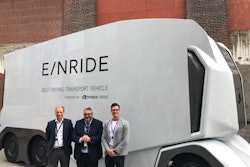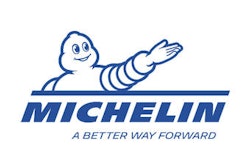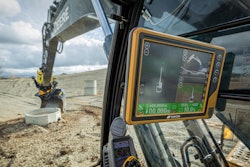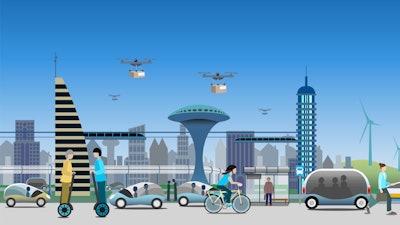
Sustainable mobility can mean a lot of different things. For many, it likely takes the form of electric or hybrid vehicles. While these are a key part of that, there are also many other technologies and factors that go into making transport of various kinds sustainable. Michelin's Movin'On sustainable mobility summit—held this week (June 1-4) as a virtual event—once again highlighted the many technological methods and investments currently being made to reduce carbon emissions across the world.
A key theme throughout the event—and a commonly held position in most industries—was the fact that no one solution is "the right solution." Instead, it will be necessary to invest in many different technology options. Anne-Laure de Chammard, Group Chief Strategy, Research & Innovation Officer at ENGIE, said during a panel discussion on energy investments that studies have shown only investing in electrification would be 30% more expensive than an optimized energy mix which includes electric and gas.
And while many advancements in electrification for heavy-duty applications have been made in recent years, there is still work to be done for very large pieces of equipment, necessitating the need for other technology or fuel options. Charging infrastructure is another key part of the equation, and may not be a possibility in some remote locations, again making it important to have other options for power equipment and vehicles. 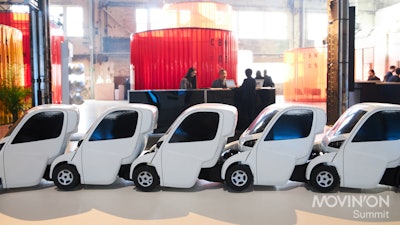 The Movin'On summit highlights an array of mobility concepts.Movin'On
The Movin'On summit highlights an array of mobility concepts.Movin'On
There is also an important need to decarbonize the electric grid, pointed out Randall Field, Executive Director, Mobility Systems Center, MIT Energy Initiative, during the energy investments panel, because so much of our society is dependent upon it, including electric vehicles.
This also brings to light the various inputs that need to be considered when developing and implementing alternative energy technologies, and how it's a wholistic approach with many aspects involved. That's one of the things I've always enjoyed about attending Movin'On over the past several years; while some of the discussions may not specifically be directly related to the industries OEM Off-Highway covers, they provide a broad scope of factors that go into decarbonization and sustainable mobility efforts.
Speakers from all over the world discuss the various ways they are looking at improving mobility; sometimes this is through the use of alternative energy, and sometimes it's the testing of new forms of transportation—such as autonomous vehicles—or ways of improving production of materials and fuels to reduce emissions.
It can also include development of new components for vehicles. Each year at the show Michelin has made new announcements related to its sustainability initiatives. At the first show in 2017, the company announced its VISION concept tire which is said to be an airless, connected, rechargeable, customizable and organic wheel and tire solution. The goal is to have the tire be made of more sustainable materials and longer lasting, keeping it from entering landfills.
Since then, Michelin has announced further sustainability goals and testing of the tire in some applications. Most recently, the company announced that by 2050 all Michelin tires will be made entirely from renewable, recycled, biosourced or otherwise sustainable materials.
During this year's summit, the company made new announcements as part of this sustainability initiative. The first is a project aimed at decarbonizing maritime shipping; the Wing Sail Mobility (WISAMO) project has developed an automated telescopic, inflatable wing sail system which can be fitted to merchant ships and pleasure craft says Michelin in its press release announcing the project.
Per Michelin's press release, the inflatable wing sail harnesses the wind, a free, universal and inexhaustible source of propulsion. Its revolutionary design enables a ship to reduce its fuel consumption and thereby have a positive impact on the environment by lowering CO2 emissions.
Michelin also unveiled a racing tire containing 46% sustainable materials which was fitted to the GreenGT Mission H24 hydrogen-powered prototype vehicle designed for endurance racing. Though made of sustainable content, the company says the tire can still provide a high level of on-track performance. 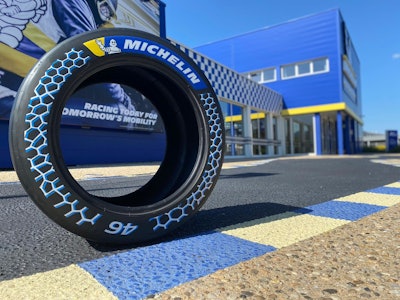 Michelin has developed a racing tire incorporating 46% sustainable materials.Michelin
Michelin has developed a racing tire incorporating 46% sustainable materials.Michelin
According to Michelin, it increased the tire's natural rubber content and used recycled carbon black recovered from end-of-life tires to achieve the high level of sustainable materials utilized. Other bio-sourced or recycled materials used include orange and lemon rind, sunflower oil, pine resin and recycled steel from aluminum cans.
"We share a core value with Movin’On and its partners, namely the deep belief that mobility, and movement in the broadest sense of the term, are inherent to life and a source of progress," says Michelin Managing Chairman Florent Menegaux in the company's press release announcing the new tire. "The two innovative solutions we are presenting at this year’s global sustainable mobility summit offer tangible, real-world proof of our determination to make mobility increasingly sustainable."
What Michelin's new project and tire demonstrate, as well as the various topics discussed during Movin'On, is that decarbonization and sustainable mobility encompass many aspects. And it will take many people working together to achieve the emissions reduction targets set out by countries, industries and organizations around the world.
We want to hear from you!
What sustainability initiatives are you most interested to learn more about? What do you think will be the next technologies coming to market which aid with decarbonization efforts? What role do you see the heavy equipment industries playing? Let us know!
Reach out to us on social media or send an email to [email protected]
Twitter: @OEMOffHighway
Facebook: @OEMOffHighway
Instagram: @oemoffhighway
LinkedIn: @OEMOffHighway





